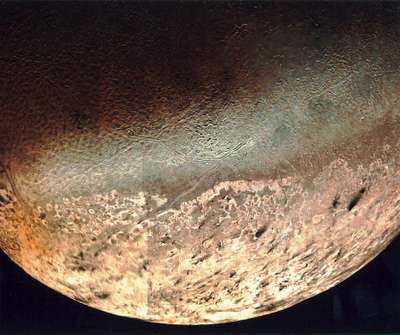Triton is unique among all the large moons in the solar system because it orbits Neptune in the opposite direction to Neptune's self-rotation. Therefore it is probably unlikely that it was created in this situation and it is possible that it was captured from another place
י

Triton, Neptune's largest moon, abandoned a previous partner and moved to orbit Neptune in an unusual orbit. Triton is unique among all the large moons in the solar system because it orbits Neptune in the opposite direction to Neptune's self-rotation. Therefore it is probably unlikely that it was created in this situation and it is possible that it was captured from another place.
In the May 11 issue of the journal Nature, Craig Agnor of the University of California, Santa Cruz, and Douglas Hamilton of the University of Maryland described a new model for capturing a satellite of a planet in a gravitational encounter between a pair and a planet. According to the script written by the two, Triton was a member of a planetary pair that orbited the Sun. Gravitational force during an encounter with Neptune pulled Triton out of its original system and made it a satellite of Neptune.
"We found a possible solution to the long-standing puzzle - why Triton came to this strange orbit. In addition, the mechanism illuminates a new path for the capture of satellites by planets that may be relevant to other objects in the solar system." said Angor, whose area of expertise is the origin, dynamics and evolution of the planets.
With similar properties to the planet Pluto and 40% more mass, Triton orbits Neptune in an inclined circular orbit between small inner moons, which move in the same direction as the rotation, and a group of outer satellites that move partly with the rotation of the planet and partly against it. There are other moons in the solar system that move against the direction of the planet's motion, including the extreme small moons of Jupiter and Saturn, but all are tiny compared to Triton (less than a thousandth of its mass) and have much more elliptical orbits than Triton's.
Triton came from a pair similar to that of Pluto and the Charon moon, Angor says. Charon is relatively massive - about one-eighth the mass of Pluto. he explains. "It is not correct to say that Charon orbits Pluto, but that both orbit the center of mass of the system, which is between them" says Agnor.
In a close encounter with a giant planet like Neptune, such a system could be torn apart by gravity. The rotational movement of the duo usually causes one of the members to move faster than the other. Disruption of the binary level leaves each of these bodies with the residual motions that can alter the trajectory. The magnon, known as a reaction exchange, could have flung Triton into a variety of different orbits around Neptune. Agnor said.
Another scenario proposed for Triton was that it collided with another satellite near Neptune but this mechanism requires the other object involved in the collision to be large enough to slow Triton down, but small enough not to destroy it. "The chance of such a collision is extremely small," Agnor said.
Another possibility is that the drag of the gases surrounding Neptune slowed Triton down enough for it to be captured. However, this scenario places limitations on the timing of the event - which occurred early in Neptune's history, when the planet was surrounded by a disk of gas, but late enough for the gas to dissipate before slowing Triton's orbit enough to not cause the moon to crash into the planet's surface.
In recent decades, several binary bodies have been discovered in the Kuiper belt and elsewhere in the solar system. The latest survey shows that about 11% of the objects in the Kuiper belt are binaries, as well as 16% of the near-Earth asteroids. "These discoveries indicate the correctness of our explanation for the capture of Triton" said Hamilton. "Binarity is a common property of small bodies."
"The Pluto/Charon pair and the binary objects in the Kuiper belt are particularly relevant to Triton, because it approaches and even crosses the orbit of Neptune." explained. Similar objects have been here for billions of years and its prevalence suggests that a colliding double planet, as we proposed for Triton capture, is not so limited." Hamilton said.
According to the two, the mechanism can explain many of the unusual orbits of moons in the solar system and the evolution of the solar system as a whole.
